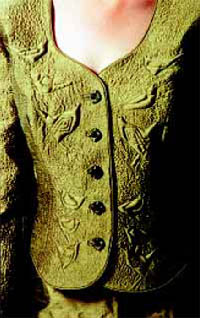
January 29, 1999

January 29, 1999 |
Spotlight on U of A apparel design |

Department of Human Ecology professor Linda Capjack, right, and graduate student Pam Bailey, winners of International Textiles and Apparel Association awards |
Look out London. Move over Milan. Intricate, creative apparel designs by the U of A's Linda Capjack and Pam Bailey, Department of Human Ecology, received two thumbs up recently at a juried competition in Dallas, Texas.
Their wearable art received awards from the International Textile and Apparel Association, the first time a faculty member and graduate student were both winners at the event. The exhibit showcased scholarly works in design and art, some of which were mounted and others presented on runways.
"Because of the quality of garments being accepted, it's an honor just to be accepted but to actually win is very exciting," said Capjack, associate professor. Out of 47 faculty entries from around the world, 30 were accepted and from 155 graduate entries, 58 were invited to attend. (U of A undergraduate student, Nicole Wahl, was also invited to submit an entry.)
Capjack entered a sage green, raw silk, formal woman's jacket and skirt. After about 100 hours of labor-intensive stitching and 3/4 of a mile of thread, "I got fed up and told myself, 'This really is for the birds,'" laughed Capjack.
Hence, her title: For the Birds.
Using an ancient, quilting technique called trapunto, she created bird images on the jacket. It required a backing fabric and fibre fill underneath the silk material. Stitching bird designs around it, with additional padding in between, created a raised effect. Wings were stitched through the layers and, to cap it off, beaded eyes brought the small birds to life. In addition, stippling filled the silk background to give texture with its maze of stitches that never cross over, said Capjack. The unquilted skirt is cocktail length and complemented with a side-front pleat.
"I've always been interested in fabric manipulation and techniques to create wearable art," said Capjack. It was her love of bird-watching that inspired the winning design. Now, she has to find an appropriate event to wear it to. "I need another daughter to get married. Maybe I'll wear it at the upcoming open house in the department."
Obviously, such a work is one of a kind - a haute couture of human ecology, if you will. Capjack can't put a price tag on it but said it would rank with high-end boutique ware. When she's not thinking of her next creative design, Capjack conducts flammability studies and researches protective clothing.
On the opposite side of the spectrum is the futuristic work of Pam Bailey, graduate student. Cables and Corset is an avant-garde look at the future of fashion.

|
Students were asked to work with a theme of metamorphosis. "I wanted to explore that. It's not a direct interpretation of metamorphosis but more about the approach of the millennium, about how we're going to bloom," said Bailey.
She created a design based on paradoxes and shock value, mixing vibrant colors: yellow, purple and red. Traditional vestiges of an older era - a hoop skirt and corset - were juxtaposed with stretch-velvet, long, flowing pants, sewn to look like a skirt. A trailing cape includes a disproportionately short jacket and long sleeves knitted together at the hand-opening, providing a cocoon effect, explained Bailey.
Trying to come up with creative ideas can be difficult but so can deciding upon a finished product. "You never know when to stop," said Bailey, who wishes, ideally, to be a textile artist. "I enjoy making pieces like this." But she plans on working in industry, in garment design or merchandising, after completing her master's degree.
Designs such as Cables and Corset add to her portfolio and provide a sample of her creativity. "It's not meant to be wearable. It's advertising. It's impractical but that's how we learn and grow," added Bailey. Still, there's always a marketable side to wild designs, she explained. She can change the corset and pants and tone down the sweater while keeping the main elements of stitch and color.
It's a learning process. "It's interesting to get feedback because you have three judges that love the design and two that just hate it."

Folio front page |

Office of Public Affairs |

University of Alberta |